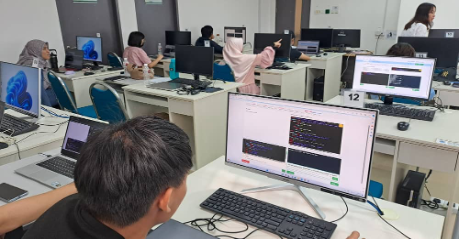Digital Skills are at the heart of the Digital Europe Programme and the EURIDICE project. This is not different for Sarawak, Malaysia. Also there, many young people are interested to learn programming, but this is a challenge for them due to a lack of platform and support. For them, learning to code is challenging and only those studying computer science are able to do it.

Yet, which programming language to choose for learning coding? Visual based programming language or text-based coding? We believe that Hedy can fill this gap. Hedy is a programming language/platform developed by Professor Felienne Hermans from VU Amsterdam. Hedy has received many responses and usage in the Netherlands and we believe it can serve as a coding platform to novice. We further argue that students learn computational thinking by learning through the Hedy platform.
A two days coding 101 training was conducted on 20-21 of July 2024. It received 30 participants from vocational study, and first and second-year universities students from UNIMAS and ICATS. The program was supported by The Ministry of Education, Innovation and Talent Development, Sarawak Skills and UNIMAS.
The training began with the basics of Hedy, a user-friendly programming language designed to ease newcomers in the world of coding. The first session focused on simple commands like print and ask, with exercises such as Rock, Paper, Scissors and Restaurant. The intuitive nature of Hedy immediately captured the participants’ attention. Many participants, who initially had no coding background, found themselves quickly grasping the concepts. The step-by-step progression of Hedy levels allowed them to build confidence as they moved from simple outputs to more complex inputs and variables.
As the training progressed to more advanced topics, including random data generation and decision-making with if and else statements, the real challenge began: debugging. For many, debugging can be a daunting task, but for these participants, it became an exciting puzzle to solve.
Participants were so engrossed in finding and fixing bugs that lunch breaks were seen as mere interruptions. In fact, many returned early from lunch breaks, eager to continue working on their code. Their determination to resolve errors before the break had even ended was a testament to Hedy’s engaging design, which made problem-solving both accessible and enjoyable.
The excitement did not stop with debugging. Some participants were so eager to learn that they continued working on higher levels of Hedy even though the lesson has not been taught yet. They delved into functions, loops, and advanced decision-making, pushing themselves to explore the full potential of Hedy.
The training fostered a collaborative environment where faster learners helped their peers, creating a community of support and shared knowledge. This camaraderie was evident throughout the sessions, as participants exchanged ideas and solutions, enhancing the overall learning experience.
The interactive exercises, such as the Fortune Teller and Dice games, were particularly popular. These real-world applications of programming concepts made the learning process relatable and engaging, reinforcing the theoretical knowledge gained in a practical setting.
The final day of training featured a Kahoot quiz, adding a competitive edge to the learning process. Participants eagerly tested their understanding of Hedy, celebrating their achievements and reflecting on their progress.
The success of this training underscores the effectiveness of Hedy in making programming accessible and exciting. By breaking down complex concepts into manageable steps, Hedy not only taught the participants how to code but also instilled in them a genuine enthusiasm for programming.
Text by Jovinah Lociah and Cheah Wai Shiang